

SCS Engineers continues to expand and advance its team of environmental professionals in Northern California by welcoming Wendell L. Minshew, a licensed professional engineer specializing in civil engineering.
“As a highly-qualified addition to the team, Wendell will help SCS Engineers provide exceptional environmental service to our clients in Northern California,” said Ambrose McCready, Vice President with SCS Engineers. “His significant background in engineering strengthens our regional team, and helps ensure we meet and exceed client objectives.”
With more than 30 years of engineering experience, Minshew specializes in leading the design, planning, permitting and construction management of solid and hazardous waste facilities. He obtained his Bachelor of Science in civil engineering from CSU Fresno and is a licensed Professional Engineer in California, Nevada, Oregon, and Arizona.
SCS serves Northern California through our offices in the San Francisco Peninsula, Sacramento, Oakland, Modesto, Santa Rosa, and Pleasanton. See our nationwide locations.
Many schools and school districts are prioritizing a shift toward zero waste and sustainability. However, learning to manage material resources on-site in a more sustainable manner presents operational and monetary challenges. Learn the benefits and steps to plan a financially sustainable program from Tracie Bills of SCS Engineers.
Tracie creates realistic approaches which allow for flexibility while maneuvering the unique challenges that occur. She takes you step-by-step through building a successful program and refers to established efforts such as in the City of San Jose that already have established zero waste programs in their schools.
Read the article by clicking here.
Deep injection wells (DIW) mean different things in different parts of the country. In the midwest DIWs have been used for decades to dispose of industrial wastewaters, mining effluent, and produced water from oil and gas production activities and are from 3,500 feet to more than 10,000 feet deep. In Florida, deep injection wells have been used since the 1960s; however, they are used to dispose of treated municipal wastewater, unrecyclable farm effluent, and in some cases landfill leachate. DIWs in Florida range from 1,000 feet to around 4,500 feet deep.
This is a two-part blog, the first part discussing what constitutes a DIW, their general features, their cost relative to other wastewater management alternatives, and the range of industrial wastewaters suitable and safe for disposal. The second part, covered in the next SCS Environment issue, will be on the challenges for deep well developers created by public and environmental organizations, and strategies to counter misinformation and means to obtain consensus from stakeholders.
A DIW construction is a series of casings set in the ground where the initial casing starts out large and subsequent casings become smaller in diameter, progressively telescoping downward. Casing materials are typically steel alloys or fiberglass for better chemical resistance. As a casing is set and rock is drilled out, the next casing is set and cemented with a chemically resistant grout. The process continues with each progressively deeper casing. These redundant “seals” are what keep the injected liquid from escaping into the protected aquifers.
A DIW typically has three upper casings to protect the aquifers and isolate the wastewater to the desired disposal zone. The inner casing, called the injection tube, extends to the injection zone. Mechanical packers seal the space between the injection tube and the last casing with the annular. The resulting annular space is filled with a non-corrosive fluid. This fluid is put under pressure to demonstrate the continuous mechanical integrity of the well. The annulus is monitored for potential leaks, which would register as a loss in pressure and promptly stop the injection. Figure 1 is a simplified view of a DIW casing system used in south Florida.
Vertical turbine pumps working in conjunction with a holding tank, which is a used to smooth out the fluctuating flow of the wastewater feed pumps, propel the liquid down the well. As part of the permitting efforts, a chemical compatibility study is conducted to determine the level of pre-treatment if any to protect the well components and minimize downhole plugging. Municipal wastewater effluent is regulated differently and must receive at least secondary treatment before injection.
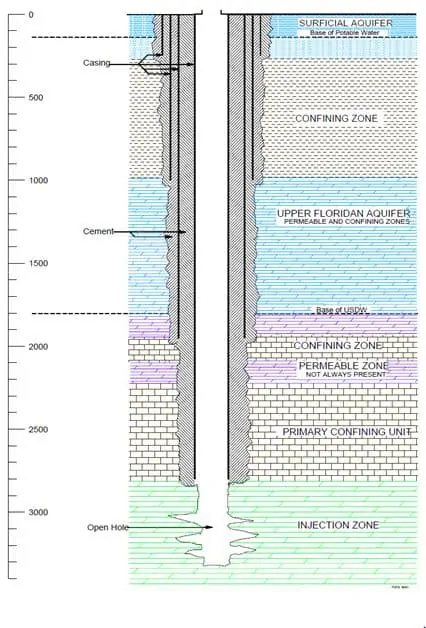
In the Midwest, DIWs are constructed to the same EPA criteria with a wide range of operating conditions. Some wells take fluid under gravity with no pumping, while others require higher pressure pumps that exceed 2,500 psi for injection. This blog focuses on wells used in Florida and typical fluid types and operational parameters.
In central and south Florida the injection zone lies below the underground sources of drinking water (USDW) which is the depth at which water with a total dissolved solids (TDS) concentration exceeds 10,000 parts per million (ppm); or the “10,000 ppm line”. This water is considered to be unusable in the future as a drinking water source. In parts of Florida, the injection zone is dolomite overlain by a series of confining units up to 1,000 feet thick made up principally of limestone with permeability several orders of magnitude less than the injection zone. (1)
In central and south Florida the target injection interval is the “Boulder Zone,” reportedly named because drilling into the formation often broke off pieces of the formation and made drilling difficult. The Boulder Zone is also known as the lower portion of the Floridan Aquifer. Later down-hole imaging technologies revealed this zone to be characterized by highly fractured bedrock and large karstic caverns, and the ability to inject relatively high flow rates with relatively little backpressure. It is not uncommon for Florida DIWs to have well flow rates exceeding 15 million gallons per day (MGD) and backpressures ranging from 30 up to 100 pounds per square inch (psi).
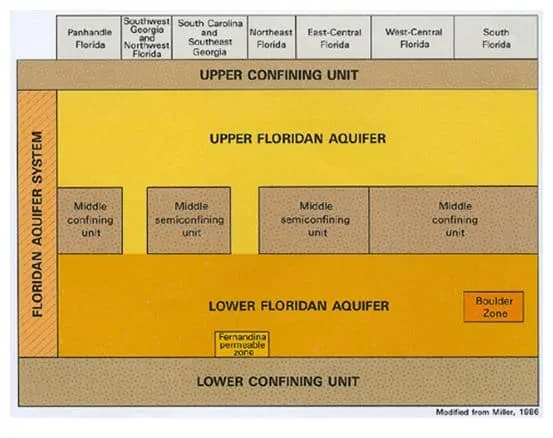
The versatility of the DIW in Florida to accommodate numerous different types of wastewater is an advantage. DIWs are being used on a large variety of waste streams that continues to expand, including:
Any wastewater considered for disposal must be compatible with the target formation and the final casing material. Therefore, depending on the wastewater, it may be straightforward to use existing industry references to confirm compatibility. In some cases, laboratory bench tests may be necessary to confirm compatibility.
Compatibility also includes the potential for creating unwanted microbial growth and scale formation within the injection interval. Growth and scale can happen with effluent containing sulfur or ammonia, two food sources for microorganisms or wastewaters supersaturated with minerals. Unless planned for and evaluated properly, both of these items have the potential to grow and clog the formation around the well, significantly reducing flow and increasing back pressure. This can result in higher energy costs, regulatory action and significant, unplanned costs to rehabilitate the well.
Another significant aspect of municipal wastewater is that they are primarily composed of freshwater and thus when injected into the highly saline Boulder Zone or similar saline zones, will tend to have a vertical migration component because of the density difference and greater buoyancy than the target zone. A few wells have been taken out of service because the seals designed to prevent this migration failed and allowed wastewater to seep upwards into the USDW.
The US EPA Underground Injection Control (UIC) program is designed with one goal: protect the nation’s aquifers and the USDW. There are several protective measures in a DIW that are intended to meet this objective;
The U.S. EPA conducted a study in 1989-1991 of health risks comparing other common and proven disposal technologies to deep wells injecting hazardous waste. The U.S. EPA concluded that the current practice of deep well injection is both safe and effective, and poses an acceptably low risk to the environment. In 2000 and 2001 other studies by the University of Miami and U.S. EPA, respectively, suggested that injection wells had the least potential for impact on human health when compared to ocean outfalls and surface discharges(3). William R. Rish examined seven potential well failure scenarios to calculate the probabilistic risk of such events.These scenarios included four types of mechanical failures, two breaches of the confining units, and the accidental withdrawal of wastes. The overall risk was quantified by Rish as from 1 in 1 million (10-6) to 1 in 100 million (10-8) (4), which is no greater than the current EPA risk criteria for determining carcinogen risk. As a comparison, 10-6 is the same risk level used by EPA for contaminants in soil or groundwater that are a known carcinogen.
There are several studies in Florida conducted by researchers and practitioners in the deep injection well field to assess the actual potential for municipal wells to contaminate the USDW. The maximum identified risk associated with injection well disposal of wastewater in south Florida is the potential migration of wastewater to aquifer storage and recovery (ASR) wells in the vicinity of injection wells (Bloetscher and Englehardt 2003; Bloetscher et al. 2005).
In a 2007 study, 17 deep wells in south Florida, used for municipal waste disposal, that had known upward migration into the USDW, were evaluated to develop a computer model to simulate these phenomena and extrapolate vertical migration over longer time periods. The results indicated that the measured vertical hydraulic conductivities of the rock matrix would allow for only minimal vertical migration. Even where vertical migration was rapid, the documented transit times are likely long enough for the inactivation of pathogenic microorganisms (5).
In a 2005 study of 90 South Florida deep injection wells, the authors took actual field data and constructed a computer model calibrated to actual operating conditions. The intent was to model performance of two injection wells in the City of Hollywood, Florida that the authors were familiar with and to determine the likelihood of migration, and what might stop that migration. Density differential and diffusion were likely causes of any migration. No migration was noted in Hollywood’s wells. The preliminary results indicate that Class I wells can be modeled and that migration of injectate upward would be noticed relatively quickly (3).
A deep injection well lifecycle cost compares favorably with other traditional waste treatment and disposal techniques. A life-cycle cost includes the capital cost and operating and maintenance costs for the useful life of the system. On a recent project, the wastewater for disposal was groundwater contaminated with ammonia nitrogen from a former landfill. The estimated groundwater recovery rate and the deep injection well disposal rate was calculated to be 1.2 million gallons per day (MGD). The proposed deep well was designed to have a final casing of 12-inch diameter, an 8-inch diameter injection tubing to a depth of 2,950 feet, and below that approximately 550 feet of open bore hole. The lifecycle cost estimate comparison to other viable technologies is shown in the Table below.
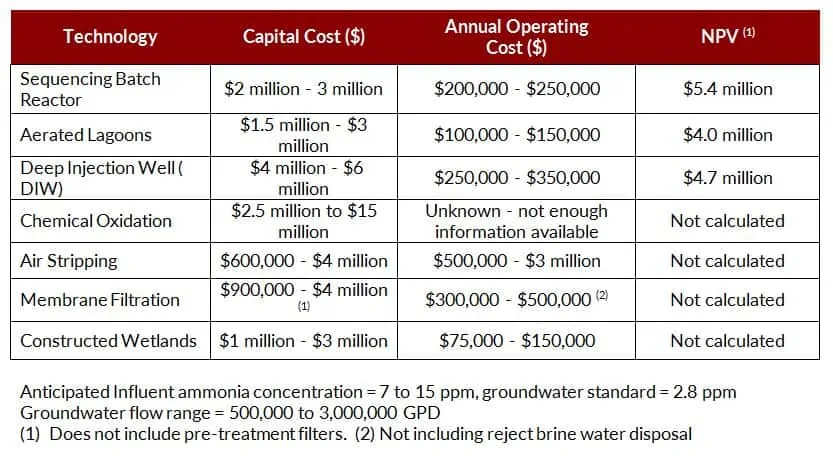
In this case, there were no projected revenues, so the alternative with the lowest net present value (NPV) would technically be the preferred alternative. Even though the aerated lagoon had the lowest NPV, it was ultimately judged too risky with a long break-in treatment period and significantly more space for treatment ponds needed.
The increasingly stringent surface water discharge standards are an ongoing challenge for industries generating a wastewater stream. DIW’s should be considered as a potentially viable option for long-term, cost-effective wastewater disposal, where a viable receiving geologic strata exists and when wastewater management alternatives are evaluated. In Florida, they currently provide an environmentally sound disposal option for many regions.
Within the SCS Engineers’ website, you will find the environmental services we offer and the business sectors where we offer our services. Each web page offers information to help you qualify SCS Engineers and SCS’s professionals by scientific and engineering discipline.
We provide direct access to our professional staff with whom you may confidentially discuss a particular environmental challenge or goal. Our professional staff work in partnership with our clients as teams. We are located according to our knowledge of regional and local geography, regulatory policies and industrial or scientific specialty.
Sometimes geosynthetic material specifications for a specific project, i.e., lining system or final cover system, is a performance-based specification which does not specify the type of product for use in construction. What does the engineer need to do when the selected contractor submits a product for approval in accordance with a performance-based specification? What should the engineer do when the owner purchases the material and identifies a product for use based on the performance-based specification?
Specifications that SCS has prepared are performance-based and include a qualifying procedure whether the product is introduced by a contractor or owner. This qualifying procedure is specifically left to the engineer to carry out by laboratory testing of typical samples of the specific product for use in construction. Typical reported values by the manufacturer or test results submitted by the contractor or owner are not acceptable under these procedures. Since the engineer is taking the liability of accepting a specific type of product for his or her project, the engineer should have the right to perform laboratory testing before the product is approved for use in the project, that only makes sense in the world of taking liabilities!
The testing performed by the engineer for qualifying a product do not count toward conformance testing of materials delivered to the site. The qualifying procedures are solely for accepting a certain type of product to be used in the project, but the specific rolls of pre-qualified product manufactured for use in engineer’s project must go through the required conformance testing specified in the specifications before use in the project.
The process of qualifying a product, ordering the qualified product, and performing conformance testing on the pre-qualified materials takes time. Engineers need to consider the amount of time necessary for the involved stages of approval into the construction schedule. If using material purchased by the owner, the owner needs to keep the timeline in mind to allow the engineer to carry out all necessary testing for the approvals to be in place before construction begins.
Repeating the qualifying procedure for a product from one project to the next depends on how the performance-based specification is written. Sometimes, the engineer accepts a product that was qualified for use in a prior project as long as the product has not changed since last used in accordance with statements by the manufacturer. If the performance-based specification includes such options, SCS highly recommends identifying the period between a prior project and the next project in the specification. In some cases, this means the product must go through a qualifying process even if it has not changed for many years but the previous set of qualifying data is older than a certain number of years. The period is based on the engineer’s judgment, but most professionals normally use five years in their specifications. During a five-year period, if the product changes or there are indications that the product might have changed due to recorded changes in certain reported values by the manufacturer, the qualifying process must be followed irrespective of the number of years passed since a recent past project to maintain quality and minimize risk.
Questions? Contact the author, Ali Khatami.
It might feel like the July 1 deadline is far away, but it is time to start preparing to report your releases of toxic materials. The U.S. Environmental Protection Agency (USEPA) indicates that printing and related industries are subject to this report. It is an important part of your environmental compliance strategy if you have a facility with at least 10 full-time equivalent employees in a covered NAICS code that exceeded a reporting threshold in the previous calendar year. Reporting releases of toxic materials on an annual basis is one aspect of the Emergency Planning and Community Right-to-Know Act (EPCRA).
Read the article with steps to your report for printing and related industries.
Consolidated List of Chemicals Subject to the Emergency Planning and Community Right To Know Act (EPCRA), Comprehensive Environmental Response, Compensation and
Liability Act (CERCLA) and Section 112(r) of the Clean Air Act
Secondary containment is a basic engineering control to prevent a chemical or oil spill. There are misconceptions, though, regarding secondary containment requirements. In terms of oil-based storage, these misconceptions can lead to not enough containment capacity, significantly more containment capacity than necessary, or simply not providing the right level of containment when containers are grouped.
Chris Jimieson of SCS Engineers explains the five most common misperceptions and advises you how to keep your facility in compliance.
Read the article by clicking here.
This article discusses global air quality and how the collaboration between policy-makers and the scientific community can have a continued positive impact on air quality in the U.S. This collaboration has been the primary cause for the improvements observed in air quality over the past few decades.
U.S. Environmental Protection Agency (EPA) programs, such as the New Source Performance Standards (NSPS), New Source Review, and Maximum Achievable Control Technology standards, have all had a significant impact on improving air quality by lowering the ambient concentrations of NOX, VOC, CO, SOX, and PM.
Some areas, such as southern California, have committed to working toward electrifying the transportation network, implementing more stringent standards on diesel fuel sulfur content, and encouraging heavier utilization of public transportation.
Author: SCS Engineers’ Ryan Christman, M.S., is an air quality engineer and environmental management information systems specialist with experience in the oil and gas industry and the solid waste industry. He is just one of SCS’s outstanding Young Professionals.
Vapor intrusion (sometimes known as soil gas intrusion or soil vapor intrusion) is a potential environmental risk that can occur at a wide variety of properties, from former industrial facilities, shopping malls, and even residential properties. Knowing how to assess the risk and mitigate potential harm from soil vapor intrusion is critical to reducing health impacts and mitigating financial and other liability from potential exposures.
What is Vapor Intrusion?
Developers and the public understand that soil and water contamination can pose a health hazard, but vapor intrusion is an environmental health risk that can be overlooked. It is a hazard that can result from both heavy industrial operations and small “mom-and-pop” businesses so that it can be an issue both at industrial properties, suburban strip malls, and even residential developments.
Vapor intrusion is the migration of soil or water contamination from below structures into businesses or homes as a vapor. Common vapor intrusion contaminants from small businesses include benzene from gasoline and perchloroethylene (perc) from dry-cleaners, while large industrial facilities may have a wide range of industrial chemical contaminants. Less common vapor intrusion hazards are mercury, polychlorinated biphenyls, and pesticides.
Determining Whether Vapor Intrusion is an Issue
Environmental due diligence is key to determining whether vapor intrusion is a likely issue. An environmental site assessment (ESA) is critical in assessing the potential for vapor intrusion issues and the current state of vapor intrusion based on past site history. A Phase I ESA will review the current and historical use of the property and surrounding properties to determine where and when potential sources of contamination were present. Leaky underground gasoline storage tanks and poor chemical handling practices at dry cleaners lead to chemical contamination that can create vapor intrusion issues, so the “corner” gas station or the strip mall dry cleaner can be the source of vapor intrusion hazards.
Vapor intrusion can also come from groundwater plumes that originate outside the property boundary, so it is important that any assessment looks for potential contamination issues from nearby properties as well as on-site.
When the potential for a vapor intrusion issue exists, a Phase II ESA should be conducted to determine whether there is contamination, the extent and magnitude of the contamination, and whether the contamination poses a significant health risk. In the Phase II ESA, samples of soil and groundwater are collected from the property and analyzed for evidence of contamination.
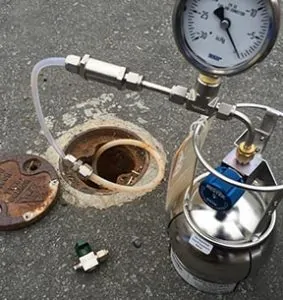
If contamination is present, results are compared to screening levels established by regulatory agencies or a health risk assessment (HRA) can be prepared. Either of these strategies can potentially be used to demonstrate that health risks are not significant for the property’s current or future use or to determine the level of remediation necessary.
Dealing with Significant Soil Vapor Contamination
If soil vapor intrusion poses a significant health risk, there are ways to mitigate that risk. Mitigation can include removal of the contamination, active mitigation of the contamination source, and protection against indoor air exposure. The approaches are not mutually exclusive, and multiple risk reduction strategies may be used.
The most effective way of reducing soil vapor risk is to remove or treat the soil or water that is the source. This remediation is the most cost-effective for small sources of contamination and when that contamination can be easily accessed. It is often not feasible to remove the source when contamination originates offsite and moves onto the property in a groundwater plume. It may also be more cost-effective to mitigate risk through other means when the source of the vapor intrusion is extensive or difficult to remove.
In active mitigation, soil vapor intrusion is mitigating by reducing contamination at the source. Active systems can include soil vapor extraction, in which vapor is collected and removed; in situ treatment, which uses chemical reagents to transform the contamination into less toxic chemicals; and containment of the contamination source by some form of barrier. Under ideal conditions, these methods have the potential to be highly effective in reducing contamination but monitor treatment for effectiveness and to determine that the resulting contamination levels are acceptable.
It is also possible to mitigate indoor air exposure to soil vapor intrusion. Underground vents, membranes, and seals beneath the foundation and slab depressurization can reduce the flow of soil vapor into a building. This type of passive mitigation leaves the contamination source in place, which may limit future uses for the contaminated property, but it may be more cost-effective than active mitigation, especially in cases where contamination originates off the property. Regulatory agencies typically require that properties mitigating the movement of soil vapor into buildings monitor the ongoing mitigation on a continuous basis with sensors and alarms or periodic resampling.
What You Need to Know
Soil vapor intrusion is a potential environmental liability, but it is manageable. Environmental due diligence can significantly reduce unforeseen costs of vapor intrusion by identifying the issue for proactive management before development, which is always easier and more cost-effective than trying to address a problem after development. It is possible to mitigate health risk from soil vapor intrusion on developed sites. Developers should work with qualified environmental consultants to address vapor intrusion through each stage of the process to adequately minimize risk.
An essential part of landfills accepting organic matter is the gas collection and control system (GCCS) for controlling odors and landfill gas (LFG) emissions into the environment; the piping network. GCCS design and construction have evolved significantly over the past four decades, from passive venting trench systems to a sophisticated and elaborate piping systems with specialized components for handling LFG, landfill liquids, and condensate flowing through the piping network.
This detailed article discusses best practices and recommendations that GCCS designers keep in mind; careful attention to these details can potentially save landfill operators significant modification costs and inconveniences prior to and during construction of the final covers.
Read the full article published in MSW Magazine.
About the Authors: Ali Khatami, Ph.D., PE, LEP, CGC, is a Project Director and a Vice President of SCS Engineers. Srividhya Viswanathan, PE, is a Senior Project Manager with over 10 years of engineering experience. David Fisher is an SCS National OM&M Compliance Manager with 18 years of environmental experience.
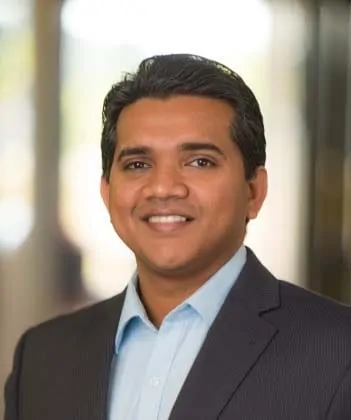
Som was born in 1983 in India, raised in Karnataka, a state in southwest India on the coast of the Arabian Sea. He has two younger brothers, both of whom work in Information Technology. His parents are retired and live in India. He grew up in a typical middle-class family with an emphasis on tradition and culture, where one is taught to respect and obey elders and to protect the young.
As a child, he was curious about how things work and admits to destroying numerous gadgets attempting to reveal their secrets – so engineering was a natural career choice. His father is a Civil Engineer who influenced Som to get a Civil Engineering degree instead of a Computer Science degree. Som has a Bachelor’s degree in Civil Engineering and came to Miami in August 2010, to earn a Masters of Environmental Engineering. While at school, he says he fell in love with the place, the people, and the culture.
Som’s wife, also an engineer, moved from Houston after their wedding in 2012. They enjoy gardening, greenery, and farms. He also collects watches and gadgets. While enamored with motorcycles, once belonging to a biking group as an undergrad, he no longer bikes out of respect for his wife and says he misses it.
Som aspires to become a leader in the industry and wants to grow with SCS Engineers. Som’s mentor is SCS Vice President and Southeast Region Office Director Bob Speed, who states,
I’ve worked with Som for several years. Som accepts tasks regardless of the difficulty and completes each promptly. Our projects usually have numerous stakeholders; Som keeps them informed, so good communications play an important role in keeping our work on-task. I would describe Som as ‘humble, hungry and smart; he truly is an ideal team player for our clients and SCS.
Som is an enthusiastic member of the SCS team. We appreciate his contributions supporting clientele, enhancing our technical reputation, and contributing to our company culture of industry involvement.